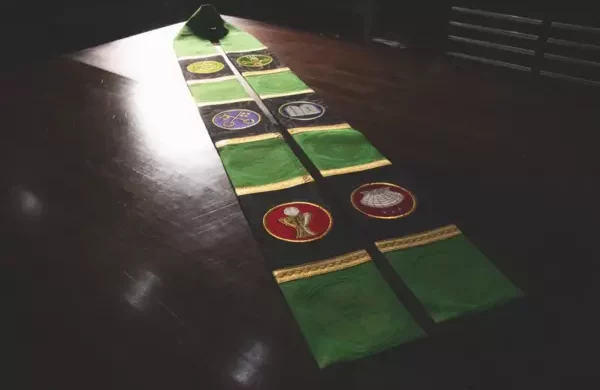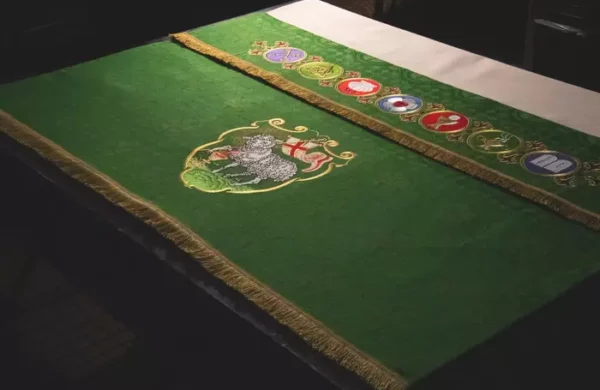
The Morse clasp, from the Latin “morsus” meaning “bite” or “catch,” is used to fasten the cope in liturgical attire. Originating between the 12th and 14th centuries, these clasps were essential for securing the cope during ceremonies. Historically ornate, featuring religious symbols and intricate designs, Morse clasps have evolved but kept their primary function. Today, they remain vital in church vestments, combining practicality with aesthetic appeal.
Like this:
Like Loading...

The six chief parts of the catechism are symbolized as follows: The Apostles’ Creed (Trinity) summarizes core Christian beliefs. The Lord’s Prayer (Censer) guides daily communication with God. The Office of the Keys and Confession (Keys) explains the Church’s authority to forgive sins. The Ten Commandments (Carved Stone) emphasize the moral law and humanity’s need for a savior. The Sacrament of the Altar (Chalice) discusses the Eucharist and Christ’s presence in it. The Sacrament of Holy Baptism (Shell) offers forgiveness, deliverance from evil, and eternal salvation.
Like this:
Like Loading...

The Luther Rose, created in 1530, symbolizes Martin Luther’s core beliefs. It features a black cross representing faith in Christ for salvation, set against a red heart, signifying a living faith. Surrounding this is a white rose, symbolizing joy, comfort, and peace, with a blue sky background highlighting eternal hope. Encircled by a gold ring, it signifies everlasting bliss in Heaven. Widely used in Lutheran churches, the Luther Rose remains a powerful reminder of the Reformation’s impact.
Like this:
Like Loading...

After the Ninety-Five Theses, Martin Luther’s ideas spread rapidly via the printing press. He translated the New Testament into German, promoting Protestantism and establishing the Lutheran Church. The “Luther Rose,” his seal, symbolizes faith, joy, and eternal life.
Like this:
Like Loading...

St. Michael’s Prayer, composed by Pope Leo XIII in 1886 after a dramatic vision, seeks protection from Satan. Initially recited by priests after Low Mass, it became widespread until the 1960s liturgical reforms. Despite this, it remains a popular devotional prayer, especially during spiritual conflicts. Pope John Paul II revitalized its use in 1994, encouraging Catholics to recite it for protection against evil.
Like this:
Like Loading...

The Triquetra, or Trinity Knot, is a symbol with deep Christian significance, representing the Father, Son, and Holy Spirit as three unified entities. Originating in Norse and Celtic cultures, it became prominent in Christian art, especially in the Book of Kells. Today, it is commonly seen in jewelry and religious art, symbolizing the unity and eternal connection of the Trinity.
Like this:
Like Loading...

“IHC” and “IHS” are both Christograms representing Jesus Christ, derived from the Greek name “??????” (I?sous). While “IHS” directly represents the first three Greek letters of Jesus’ name, “IHC” uses the same letters with the sigma (?) stylized as “C” in Western Christian tradition. Despite this visual difference, both symbols carry the same meaning and are widely used in Christian art and symbolism to denote reverence for Jesus Christ.
Like this:
Like Loading...

In today’s world, churches face the temptation to adopt secular trends like efficiency and minimalism, risking the loss of their rich traditions and artistic beauty. Embracing these trends dilutes their role as beacons of inspiration. Art and beauty in church worship serve as powerful tools of evangelism, drawing people to their beauty and spiritual depth. Preserving these traditions is crucial for Christians, ensuring a legacy of faith and uniqueness.
Like this:
Like Loading...

The Church, portrayed as the Bride of Christ, beautifully illustrates the profound love and faithfulness between Christ and His followers. This metaphor highlights a deep, sacrificial love akin to a marriage, as described by St. Augustine and St. John Chrysostom. It emphasizes the Church’s role in reflecting Christ’s purity and maintaining a loving relationship with Him. Ultimately, it points to a joyous future union with Christ, celebrated as the marriage supper of the Lamb in Revelation—a testament to the enduring bond between Christ and His Church.
Like this:
Like Loading...

We’re thrilled to announce an expansion of our jewelry selection, now available at discounted prices for a limited time. These special prices won’t last long—once our collection is complete, prices will go up. So, if you see something you love, grab it now! We value your input and welcome suggestions for new items to carry. Exciting news: a Luther Rose pendant and pectorals are coming soon, along with new sacred heart necklaces. Don’t miss out on these exclusive deals and upcoming arrivals!
Like this:
Like Loading...

The Feast of St. John the Baptist, celebrated on June 24th, honors his role in preparing the way for Jesus. John emphasized repentance, courage, and humility. Theologians like St. Augustine and Thomas Merton highlight his significance in transitioning from the Old to the New Testament and the importance of solitude and prayer. John’s example inspires us to live with courage, humility, and a call to repentance.
Like this:
Like Loading...

Anthony of Padua, born in 1195 in Lisbon, Portugal, is a beloved Catholic saint known for his powerful preaching and deep scriptural knowledge. Initially an Augustinian, he joined the Franciscan Order and preached across Italy and France. Celebrated on June 13, he is the patron saint of lost items and is revered for his compassion, humility, and devotion to the poor. His life exemplifies faith, perseverance, and service, inspiring modern believers to trust in God’s plan and show compassion to others.
Like this:
Like Loading...

In this parable, a grand feast symbolizing the Kingdom of Heaven is prepared, but many decline due to worldly distractions. Yet, the host welcomes the marginalized, illustrating God’s boundless grace and inclusive nature. It’s a reminder that divine hope is always extended, regardless of our circumstances.
Like this:
Like Loading...

June, celebrated as Sacred Heart Month, honors the Sacred Heart of Jesus, symbolizing His love and sacrifice. Formalized in the 17th century, this devotion also venerates the Most Chaste Heart of Saint Joseph and the Immaculate Heart of Mary, representing purity and maternal love. The month encourages reflection and active devotion, inspiring deeper spiritual maturity and a closer relationship with the divine.
Like this:
Like Loading...

We’re thrilled to announce the launch of our linen kit for the upcoming Sacred Heart project in collaboration with ClaraStitching. Download your free printable patterns from the provided Dropbox link and note that only fifty linen kits are available, so act fast! Clara Stitching will be hosting a free hand embroidery class on June 15th; sign up for updates via her forum link.
Like this:
Like Loading...
















You must be logged in to post a comment.